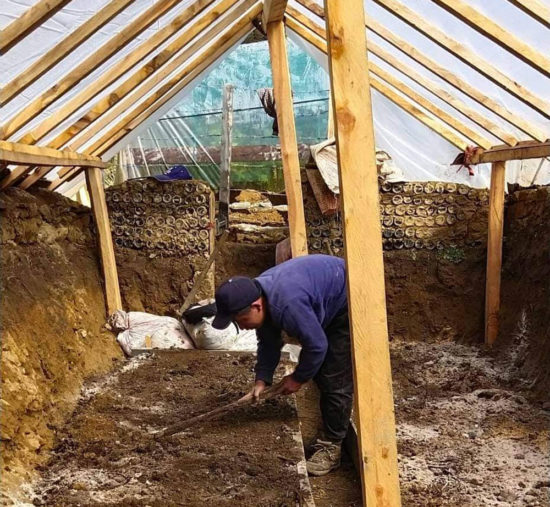Thukten Zangpo
Highlanders in Laya, Gasa are going to try the sunken bed technology to grow vegetables even in winter.
Vegetables are cultivated by digging holes of 1.5 metres in the greenhouse. This would regulate the soil temperature during extreme winters.
With the distribution of greenhouses to all households since 2016, the villagers have enough vegetables in summer.
Gewog agriculture extension officer of Laya gewog, Tselthrem Dorji said, “However, growing vegetables in a normal greenhouse in winter is still a challenge.”
As per the crop production record of the gewog agriculture office, vegetable production has increased from 16 metric tonnes (MT) in 2017 to 20MT last year.

A villager prepares the soil to plant vegetables
The gewog agriculture office provided free materials required for the poly house, distributed vegetable seeds, and provided training on vegetable management and the operational aspects.
There were only a few greenhouses in 2011. According to Tshelthrem Dorji, Layaps then grew only vegetables like turnips, radishes and spinach.
Now, they can grow cucumber, chilli, brinjals, and crow beak (Cyclanthera Pedata) for self-consumption in the greenhouse, he said.
With the warming temperature in the highlands, Tshelthrem Dorji said that the low land vegetables like spinach, radish, coriander, turnip, broccoli, and cauliflower can also be grown in the open field unlike in the past.
A villager from Nyelu village, Tshering Lham said that the vegetables are adequate for about 3 to 4 months. “However, we wish the yield could be more.”
She said that they still buy vegetables from nearby dzongkhags during winter.
With freezing temperatures most of the year, the highlanders could only grow staple crops like barley and wheat once a year.
With the legalisation of the cordyceps collection in the highland, barley and wheat production has declined over the years and they depend on imported rice.
Tshelthrem Dorji said that the gewog was unable to re-distribute the greenhouse materials to the villagers. The greenhouses had a durability of only four years and have all worn out.
He also claimed that the pests- large white butterflies in the cauliflower, aphids in spinach and chilli have infested this year because of warmer temperatures. “There were no such cases in the past.”
Given the decline in the cordyceps collection in recent years and the risks of food shortage amid Covid-19 pandemic, the gewog agriculture official said that villagers are increasingly interested in cultivating vegetables and rearing livestock.


